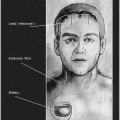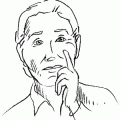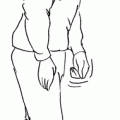and Kelvin L. Chou2
(1)
Parkinson’s Clinic of Eastern Toronto & Movement Disorders Centre, Toronto, ON, Canada
(2)
Michigan House, University of Michigan Medical School, Ann Arbor, MI, USA
Keywords
EpidemiologyGeneticsPathophysiologyClinical featuresEssential tremor (ET) is one of the most common neurological disorders and is characterized by the presence of action tremor of the hands [1]. It is also known variably in the medical literature as Familial Essential Tremor and Benign Essential Tremor. The use of “benign” in front of ET is misleading, as the tremor may be quite disabling [2, 3]. Similarly, not all cases of ET are familial. Thus, the condition is best termed “Essential Tremor”.
Epidemiology
ET can affect anyone at any age. Based on tertiary center referrals, the distribution of age at onset is bimodal, with a small peak at around 20 years of age and another one around 60 years of age [4–6], though in population based studies, there may be just one large peak later in life [6]. About 5–15 % of ET cases occur during childhood [4, 6, 7]. Prevalence estimates vary widely because of differing diagnostic criteria, but is present in approximately 1 % of the general population, approximately 4–5.6 % of patients aged 40 or older [8, 9], and approximately 6–9 % of patients aged 60 or older [1, 8, 9]. An age-associated increase in the prevalence of ET is consistently found across all studies [1, 9]. Applying these prevalence rates to United States census figures, almost five million people in the United States over the age of 40 are affected with ET. Overall, tremor appears to occur with similar frequency in men and women [4]. This condition is common in all races across the world, though may be slightly higher in Caucasians than African-Americans [10].
Genetics/Environmental Risk Factors
The exact cause of ET is unknown. Because patients with ET are five times more likely to have first degree relatives with tremor compared to the general population, it is largely considered a genetic disorder [11]. The genetics of ET, however, are not yet clear. In a significant number of cases, ET is hereditary and transmitted in an autosomal dominant pattern. Mutations in chromosome 2p22-25, 3q13, 6p23, and the fused in sarcoma (FUS) gene have been suggested to be the disease loci in some of these dominantly inherited families, though there are families with dominantly inherited ET without a link to these loci [12–16]. Genome-wide association studies have identified sequence variations in the LINGO1 (leucine-rich repeat and Ig domain containing 1) and SLC1A2 (glial glutamate transporter) genes in European subjects as possible genetic risk factors for ET [16].
Up to 50 % of ET patients do not have affected relatives, suggesting that environmental factors may also play a role [17]. This is supported by the lack of complete concordance in monozygotic twins with ET [18] and the existence of wide differences in age of onset and severity of tremor within families. Harmane (1-methyl-9H-pyrido[3,4-b]indole) has turned out to be an intriguing possible environmental toxin connected to ET. Harmane is a tremor-producing β-carboline alkaloid found in cooked meat, and elevated blood and brain harmane concentrations have been found in ET patients in large case-control studies [18–20]. There have also been associations between lead and pesticide exposure and ET, but more work is needed to more firmly establish all of these toxins as definitive risk factors [18].
Pathophysiology
The pathophysiological mechanisms of ET are poorly understood. Central nervous system pathology is supported by the observation that thalamotomy, thalamic deep brain stimulation and centrally acting drugs may improve tremor [21, 22]. The cerebellum in particular may play an important role in pathophysiology of ET. It has been suggested that ET originates from the inferior olivary nucleus of the cerebellum, in cells displaying inherent oscillatory-pacemaking properties [23]. These central oscillators are normally kept in check by inhibitors such as the neurotransmitter GABA, but such a mechanism could be defective in ET [24]. Abnormal oscillation would then propagate through the cerebello-thalamo-cortical network, resulting in tremors. This theory is supported by findings that lesions or injury of regions within the thalamus where the cerebellum sends its information reduces the intensity of ET [22, 25, 26]. Neuronal discharges correlated with tremor have been observed to occur in the ventrolateral thalamus, particularly in the ventralis intermedius nucleus [27]. Contralateral limb tremor can be suppressed by the ablation or high frequency stimulation of the ventralis intermedius nucleus of thalamus [22, 28].
The neuropathology of ET is controversial. There have been some studies reporting neurodegenerative changes in the cerebellum of patients with ET, including Purkinje cell loss, increased Purkinje cell axon swelling (torpedos), and decreased Purkinje cell linear density [29, 30]. However, other clinicopathologic studies of ET have reported no significant cerebellar pathology [31, 32]. Thus it remains unclear if ET is a neurodegenerative disorder.
Clinical Presentation
Tremor Characteristics
The hallmark of ET is an action (kinetic and postural) tremor of the hands [4, 5]. This is different from the tremor seen in Parkinson disease, which is a rest tremor (tremors improve with use of the affected limb) [33]. A variety of common tasks may be affected in ET. Writing may be tremulous, and the size of handwriting is usually large (macrographia). This in contrast to Parkinson disease, in which the size of handwriting typically becomes small (micrographia) [33]. When tremor is severe, patients may not be able to sign checks and may even have difficulty keeping the pen on the paper. ET patients also report trouble holding objects like a cup of coffee, and can have problems using utensils to eat. When moderate, they may spill liquids or food and many develop ways of accommodating the tremor, such as using two hands to hold a cup or by filling their cups partway. When in public, patients may avoid ordering certain menu items such as soup because of the potential for embarrassment [34]. In some cases, patients’ tremors may be so severe that they need to put lids on their cups or drink from a straw in order not to spill. Other tasks that may be affected by the tremor in ET include dressing, shaking, putting on makeup, putting keys in locks, and using a screwdriver.
Tremor frequency in ET may range from 4 to 12 Hz, but is more typically in the range of 7–10 Hz [35, 36]. The tremor frequency usually slows down with age, at a rate of about 0.07 Hz per year [37]. This decrease in frequency causes a gradual increase in tremor amplitude over the years. In fact, ET patients with high amplitude tremors often oscillate at a lower frequency [38]. On examination, ET typically causes a flexion extension movement at the wrists, and/or abduction movement of the fingers. A pronation-supination (pill-rolling) tremor of the hands is more typical of Parkinson disease and is present in ET in only a minority of cases.
The tremor of ET is usually symmetric or only mildly asymmetric [4, 5]. The presence of unilateral hand tremor would be more consistent with the presence of other conditions, like early Parkinson disease, focal dystonia or primary writing tremor. Though ET and Parkinson disease are distinct clinical entities, there is some evidence that the 2 disorders may overlap. In some family studies of Parkinson disease, there is a co-occurrence of ET above what would be expected by chance alone [39, 40]. Additionally, some studies have reported an increased risk of developing Parkinson disease/Parkinsonism in ET patients [41, 42]. Other studies have indicated that the prevalence of preceding ET among a population of Parkinson disease patients is not higher than the prevalence of ET in the general population [43]. These conflicting findings may be due to varying definitions of ET and the different methods of ascertainment. Future studies will hopefully clarify the connection between ET and PD.
As mentioned earlier (see Genetics/Environmental Risk Factors), patients often have a family history of tremors. Most patients with ET seek attention only if they have a functional or social disability because of tremor. ET may result in social phobia due to embarrassment. Embarrassment is present in nearly half of ET cases with no head tremor and only mild arm tremor, so severity of tremor is not associated with embarrassment [34]. Younger patients and women tend to have more embarrassment, and the presence of embarrassment is associated with greater medication use [34].
Other Body Parts Affected
Though ET typically affects the upper extremities and the hands, it may also involve other body parts. Typically, the tremor spreads upwards to the head, then the voice [4, 5]. Tremor may also affect the legs, jaw, tongue, and trunk, though not as often as the head and voice [4, 5]. If these other body regions (head, voice, legs, jaw, tongue, and trunk) are involved, the tremors typically occur in conjunction with hand tremor and are rarely present in isolation [4, 5]. The presence of isolated head tremor suggests cervical dystonia, while an isolated voice tremor suggests laryngeal dystonia [44].
ET head tremor may be in a “no-no” or a “yes-yes” direction [4]. A rotatory head tremor suggests the possibility of cervical dystonia. Patients are often unaware of their head tremor and know they have it only because others point it out [45]. Women with essential tremor are more likely to develop a head tremor [44]. Voice tremor is generally of insidious onset. Patients may complain of voice changes and an increased effort to speak, but not necessarily a voice tremor. Women and patients with an older age of tremor onset are more likely to develop voice tremor [46]. Jaw tremor is typically associated with more severe and widespread tremor involvement [47]. Jaw tremor in ET may be confused with the perioral tremor of Parkinson disease, in which the lower lip and chin are affected.
Exacerbating/Alleviating Factors
Fatigue, stress, central nervous system stimulation, sexual arousal, emotional excitement and temperature extremes can exacerbate the tremor in ET [4]. In up to 60–70 % of ET patients, tremor is dampened by intake of alcohol [4, 5]. The effect of alcohol seems to be centrally mediated [21]. The history of response to alcohol is helpful diagnostically, though it does not have to be present to make the diagnosis. Caffeine on the other hand, may precipitate tremor. ET, like most other movement disorders, disappears in sleep. Occasionally, patients may complain of an especially coarse tremor upon awakening in the morning.
Other Associated Motor and Non-motor Features
It should be noted that studies on other features of ET are somewhat controversial and inconclusive. Gait abnormalities have been reported in patients with ET, including postural instability and ataxia [48, 49]. These gait changes are beyond that seen with normal aging, and may result from cerebellar dysfunction. Mild eye movement abnormalities have also been reported in ET patients [50]. Non-motor features that have been reported in ET include cognitive problems, personality changes, and depression/anxiety [2, 51]. Cognitive deficits are typically mild in nature, especially when compared to patients with Alzheimer’s disease and Parkinson disease, and detectable only with sophisticated neuropsychological tests [2, 51–53]. Attention and executive function seem to be the cognitive domains that are consistently reported to be affected [53]. Several studies have reported that older onset of ET is associated with an increased risk of developing dementia [54, 55], but it is still not clear if this is due to ET or aging. A shy, doubtful and worrisome personality has also been associated with ET [56, 57], but another study instead found ET associated with more aggressiveness and hostility [58]. ET is associated with higher anxiety scores and higher levels of depression than in the general community [58, 59]. It is unclear if this is due to underlying pathophysiology of ET, the presence of tremor, embarrassment from tremor, or all of the above.
Disease Progression
ET typically worsens over time, though progression is not linear. As the amplitude of tremor increases, the frequency of tremor may decrease [37]. Of those ET patients who seek medical care, more than 90 % of them report disability from the tremors [60]. Up to a quarter of ET patients are forced into early retirement [2, 4]. In general, it has been reported that ET does not affect life expectancy, though there is a population-based study suggesting a 45 % increased risk of mortality in ET [61].
References
1.
2.
Louis ED, Okun MS. It is time to remove the ‘benign’ from the essential tremor label. Parkinsonism Relat Disord. 2011;17:516–20.CrossRefPubMedCentralPubMed
3.
Busenbark KL, Nash J, Nash S, Hubble JP, Koller WC. Is essential tremor benign? Neurology. 1991;41:1982–3.CrossRefPubMed
Stay updated, free articles. Join our Telegram channel

Full access? Get Clinical Tree







